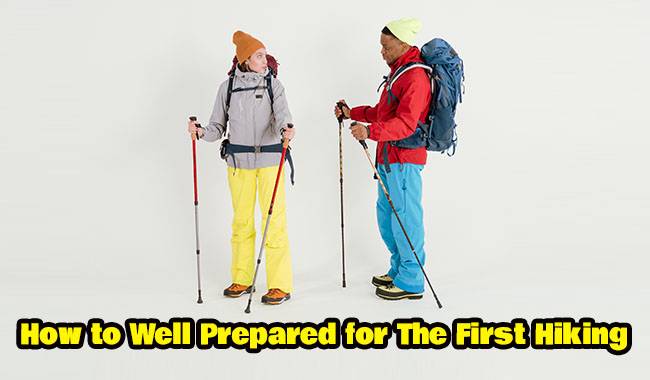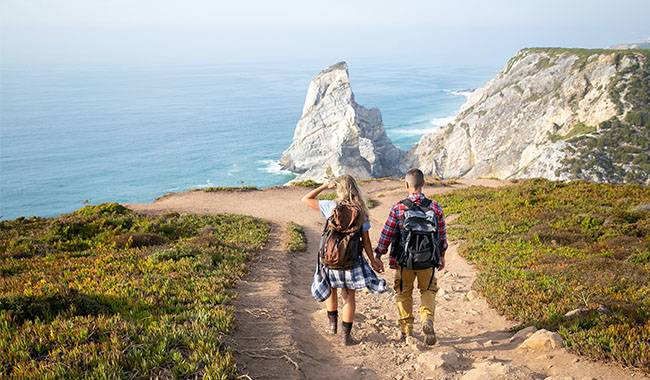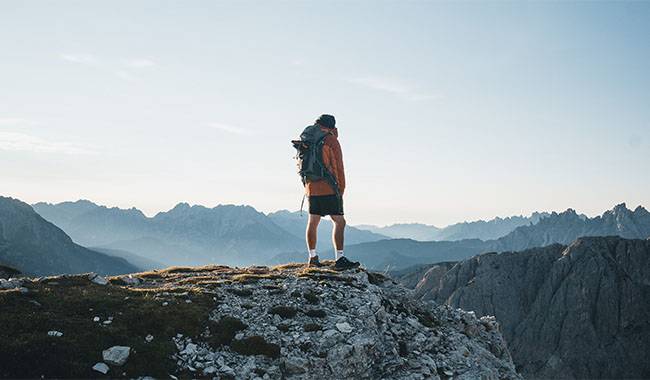
“I want to go camping!” – One day, you decide. If this is your first time, I’ll tell you what to do next so you don’t end up like me. You will learn more about How to Well Prepared for The First Hiking by LCN Outdoors article.
On my first hike, I flew off the pass and broke down. The second time, I froze at night, got scared by the rain, and went home because I’d had enough. The third time, I was soaked to the bone and too cold to take off my own shoes. Oddly enough, I didn’t give up on it, but the next three dozen hikes went by with little to no incident. That’s what you should do to avoid repeating my mistakes.
Exercise
Before my first hike, I had only one desire to get into the mountains, but nothing to prepare for it. I had never exercised or slept in a tent, and I only took my backpack into the countryside. It turned out badly.
The first day in the mountains was an ordeal – walking hard with the pack on my back and no energy to enjoy the scenery. The level of fatigue on the ascent to the first pass is indescribable. I didn’t reach the pass – on a steep slope I slipped and fell on the rocks, and spent the next two weeks in the local hospital. This would not have happened if I had any strength left and if I had known what to do in the event of a breakdown on a snowy slope.
Proper preparation for a hike should be physical and technical.
Physical fitness is about endurance training. It determines how safe and fun the hike will be because hikers with high endurance have more energy to see the beauty of the mountain. That’s why you should train before you hike, and the sooner you start, the better. If you’ve never done any exercise before, you should start training at least three months before your hike.
The best endurance training is running, and the secret to good training is regularity. It’s better to run 1.86 miles (3 km) five times a week than to run 9.3 miles (15 km) on the weekend and then do nothing for a week. For people who have never run before, the best time to train is three to four times a week for 3 miles (5 km).
If running isn’t for you for some reason, there are other aerobic options. You can swim, ride a bike or go skiing in the winter. The important thing is that it should be exercised, that is until you get tired, and it should be regular.
To your aerobic training, you should add exercises for general physical training. These are the common squats, push-ups, and pull-ups. They strengthen the leg and back muscles, which are very important for hiking.
Technical training is all about practicing on the mountain. It is not necessary for easy hiking, i.e. hiking on good trails, but it is essential where it is necessary to cross snowy or rocky slopes. In most cases, this training is organized on-site during the first days of the hike. For example, if the route runs on a steep snowy slope and you may need ice axes, trekking poles, or both, the guide or leader will choose a safe slope and teach a snow course. There, he or she will teach beginners how to walk on snow, how to hold an ice axe properly, and how to use it in case of a breakdown.
Tip: If you don’t know how to use an ice axe, the ice axe itself is useless and sometimes dangerous – it’s easy to get hurt by your beak or shovel. So if your leader or guide tells you to bring an ice axe, but doesn’t tell you how to use it, ask for technical training on the first snow slope.

Be Prepared Mentally
When I did my second hike, I was in good shape: I had been running 3-4 miles (5-7 km) 4 times a week in all kinds of weather for almost a year. The walking was easy and I didn’t feel tired. But everything else is annoying.
For example, the snow in May. I was expecting beautiful scenery, but with rain on top, snow below, and water in the tent, it was abominable. I had to walk in a polyethylene raincoat – I didn’t have a film jacket at the time and it was the only thing that saved me, but it was hot and uncomfortable. The rain made me so angry. And the participants – this guy was like a snail, we waited for him for half an hour at the break and we froze. Couldn’t they have trained before the hike? And a stew with meat for breakfast. Can we eat that? It was annoying.
In the meantime, my tenant is enjoying life. She was born into a family of hikers, grew up camping or rafting every weekend, slept in a tent more often than she slept in a bed, and could eat stew three times a day. She was fine, even when she unscrewed her sleeping bag before we went to bed. It was also infuriating.
Some people get used to camping right away. But for most people like me – who haven’t camped since they were kids – it’s uncomfortable in principle. But you can get used to it. First, simply accept the fact that it will be difficult at times, that you will have to live in unfamiliar conditions and do unfamiliar things – like walking in the rain, wearing wet boots in the morning, sleeping on hard ground, not showering for days or bathing in icy streams, etc. The main thing to understand is that you will get used to this over time, even during the trek. If on the first day you think: “How can I survive here? – Then, on the fifth day, the same thing seems to become the norm.
Some of the challenges of camping can be solved with good equipment and planning. For example, buy membrane socks that keep your feet dry when your boots are wet, buy a soft self-inflating pad instead of a mat, and use a membrane jacket instead of a plastic raincoat. Think carefully about the menu and work out a ration of normal food instead of stews and ankle horses. But it’s all still in the mind. The mind is as trainable as the body.
But hikers have many pleasures that those who have never been on a hike cannot understand. For example, when the sun comes out after a rain and dries your clothes quickly. The warmth of an evening campfire. The breathtaking sunsets and sunrises over the mountains. And finally, the return to civilization – for example, the joy of another hot shower after two weeks of hiking. All of this is worth keeping in mind, and remembering when you want to give it all up. Even if the first hike isn’t always perfect, the negative moments are usually forgotten, leaving only the good stuff behind.

Be Well-equipped
On that hike, I got really cold at night – the sleeping bag I rented from the hiking club for a warm summer day turned into a snowy May day with frost in the mountains. After the third sleepless night in a bad mood, I left the trail. The beauty of nature was no longer of interest and I wanted to sleep well instead of being frozen all night.
I later found out that snow and frost are common in the mountains in May. In my city, it’s plus 30 this time of year, so who would have thought? But the first thing to do before you start packing is to know the weather in the area, as this determines what clothes and equipment to bring.
For example, sleeping bags have an indicator, such as comfort temperature. If it is plus 50 °F (10 ° C), at zero degrees, that sleeping bag will be very cold. Therefore, you should always know in detail the typical temperature for that camping area at that time of year, what altitude you will be spending the night at, and any other surprises that may exist.
On my third hike, I felt physically and mentally prepared for everything. I bought a -9 degree warm sleeping bag. I threw away my McIntosh and borrowed a membrane jacket from a friend. And everything was fine until it started to rain.
We walked in this rain for half a day. The jacket I borrowed from my friend turned out to be so old that it wouldn’t keep the rain out, and I had forgotten to bring my GPS. By the time I got to camp, I could have been wrung out. Since the rain was not summered at all (it was May again), I was very cold and in the camp, my friend took my shoes off: my hands were not working and I could not even untie them. I shivered in my tent for a long time afterward.
I bought a nice membrane jacket for my next camping trip. And I always take it and a McIntosh with me, just in case. You never know.
The list of necessary equipment and clothes depends on the conditions in the area and on the route. This list is always given by the leader, so you don’t need to make anything up, but you can ask and clarify it. It is important not to be afraid to consult the organizer because he knows the area best and will tell you why to take this or that thing, even if you think it is not necessary. For example, not everyone knows that there may be snow in the mountains in mid-July and therefore ignores the “down jacket” item in the equipment list and then freezes at night in the camp.
You can buy your clothes and equipment gradually, or borrow things from friends or hiking clubs to start. The most important thing is to check the comfortable temperature of your sleeping bag and the waterproofness of your membrane clothing. And in order not to make mistakes when choosing your own equipment, it is best not to buy randomly, but in a good store with a knowledgeable advisor. And before that, watch the lectures of our experts and read the article about choosing equipment.
How To Choose Equipment For The First Trip
To sum it up. To have a successful first camping trip, you should be prepared beforehand – especially if you’ve never lived in a tent or played sports before. Here’s what to do.
- train your endurance: run, swim, ride a bike.
- Practice your skills: If you plan to hike on difficult terrain and need special equipment, you should know how to use it and what to do in the event of an accident.
- Train your endurance: Camping is not always comfortable, but if you set yourself up properly, it will be easier to adapt.
- Soothe your daily discomfort with good equipment: pick a warm sleeping bag, a comfortable backpack, a soft inflatable pad, membrane clothing, membrane socks.
If you haven’t decided which hike you want to go on and with whom, read our articles “Camping related articles” and “Hiking related articles“. Have a great hiking trip!